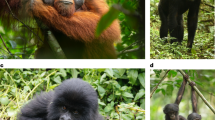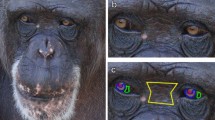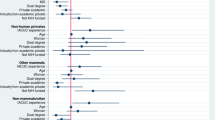Abstract
As one of humankind's closest animal relatives, the chimpanzee has proven to be a valuable but controversial research model. The author provides an overview of efforts to improve chimpanzee welfare, and describes a facility dedicated to providing lifelong care for these nonhuman primates following retirement from research.
This is a preview of subscription content, access via your institution
Access options
Subscribe to this journal
We are sorry, but there is no personal subscription option available for your country.
Buy this article
- Purchase on Springer Link
- Instant access to full article PDF
Prices may be subject to local taxes which are calculated during checkout




Similar content being viewed by others
References
Brent, L., Butler, T.M. & Haberstroh, J. Surplus chimpanzee crisis: planning for the long-term needs of research chimpanzees. Lab Anim. (NY) 26(9), 36–39 (1997).
Brent, L. The future of long-term chimpanzee care: an update. Lab Anim. (NY) 29(1), 51–55 (2000).
IUCN/SSC Primate Specialist Group. African Primates: Status Survey and Conservation Action Plan revised edn (ed Oates, J.F.) (IUCN, Cambridge, UK, 1996).
Walsh, P.D. et al. Catastrophic ape decline in western equatorial Africa. Nature 422(6932), 611–614 (2003).
Wildlife Conservation Society Uganda chimp numbers higher than thought. (31 January 2003). http://wcs.org/7411/?art=28624771.
Farmer, K.H. Pan-African sanctuary alliance: status and range of activities for great ape conservation. Am. J. Primatol. 58(3), 117–132 (2002).
de Waal, F. Chimpanzee Politics: Power and Sex among Apes revised edn (Johns Hopkins University Press, Baltimore, MD, 1998).
Goodall, J. The Chimpanzees of Gombe: Patterns of Behavior 5–42 (Belknap Press, Cambridge, MA, 1986).
Boysen, S.T. in The Development of Numerical Competence: Animal and Human Models (eds. Boysen, S.T. & Capaldi, E.J.) 39–59 (Lawrence Erlbaum Associates, Hillsdale, NJ, 1993).
Muchmore, E.A. Chimpanzee models for human disease and immunobiology. Immunol Rev. 183, 86–93 (2001).
Cantalupo, C. & Hopkins, W.D. Asymmetric Broca's area in great apes. Nature 414(6863), 505 (2001).
Britten, R.J. Divergence between samples of chimpanzee and human DNA sequences is 5% counting indels. Proc. Natl. Acad. Sci. USA 99(21), 13633–13635 (2002).
Yerkes, R.M. & Yerkes, A.W. The Great Apes: A Study of Ansthropoid Life (Yale University Press, New Haven, CT, 1929).
Brent, L. in The Care and Management of Captive Chimpanzees (ed. Brent, L.) 1–15 (American Society of Primatologists, San Antonio, TX, 2001).
Institute for Laboratory Resources, National Research Council. Chimpanzees in Research: Strategies for their Ethical Care, Management, and Use 1–6 (National Academy Press, Washington, DC, 1997).
Home Office. Statistics of Scientific Procedures on Living Animals Great Britain 2002 Presented to Parliament by the Secretary of State for the Home Department by Command of Her Majesty. (The Stationery Office, London, UK, 2003). http://www.official-documents.co.uk/document/cm58/5886/5886.pdf.
Animal Rights Sweden. Sweden bans experiments on great apes. (9 April 2003). http://www.djurensratt.org/articles/article.asp?id=615.
New Zealand Ministry of Agriculture and Forestry. Guide to the Animal Welfare Act 1999. MAF Policy Information Paper No. 27. (December 1999). http://www.maf.govt.nz/biosecurity/legislation/animal-welfare-act/guide/awguide.pdf.
De Kok, W. Last European research chimps to retire. Lab Primate Newsl. 42(1), 26 (2003).
Goodman, S. & Check, E. The great primate debate. Nature 417(13), 684–687 (2002).
Prince, A.M., Brotman, B., Garnham, B. & Hannah, A.C. Enrichment, rehabilitation, and release of chimpanzees used in biomedical research: procedures used at Vilab II, The New York Blood Center's laboratory in Liberia, West Africa. Lab Anim. (NY) 19(5), 29–37 (1990).
DHHS, NIH. Request for chimpanzee sanctuary capability statements. Federal Register 66(76), 20150 (19 April 2001).
NHLBI, NIH. NHLBI-RR-P-01-759. Operation and Maintenance of a Sanctuary to Provide Lifetime Care for Chimpanzees. (28 September 2001). http://www.nhlbi.nih.gov/funding/inits/archive/rrp01759.pdf.
NIH. NIH funding establishes a chimpanzee sanctuary. NIH News Release (30 September 2002). http://www.nih.gov/news/pr/sep2002/ncrr-30.htm.
Bailes, E. et al. Hybrid origin of SIV in chimpanzees. Science 300(5626), 1713 (2003).
de Groot, N.G. et al. Evidence for an ancient selective sweep in the MHC class I gene repertoire of chimpanzees. Proc. Natl. Acad. Sci. USA 99(18), 11748–11753 (2002).
NHGRI. NHGRI prioritizes next organisms to sequence. (May 2002). http://www.genome.gov/10002851.
Olson, M.V. & Varki, A. Sequencing the chimpanzee genome: insights into human evolution and disease. Nat. Rev. Genet. 4(1), 20–28 (2003).
Wildman, D.E., Uddin, M., Liu, G., Grossman, L.I. & Goodman, M. Implications of natural selection in shaping 99.4% nonsynonymous DNA identity between humans and chimpanzees: Enlarging genus Homo. Proc. Natl. Acad. Sci. USA 100(12), 7181–7188 (2003).
Acknowledgements
The author appreciates the review, comments, and information provided by Raymond O'Neill, William Watson, Linda Koebner, Janet Gonder, Carole Noon, Kate Conlee and several reviewers. Figures 1–3 courtesy of Elizabeth Glover. In addition, the author credits Jo Fritz with recognizing long ago that if any species was potentially able to succeed in bringing the animal researchers and the animal protectionists together to work cooperatively, it would be the chimpanzee. This work was supported in part by N02-RR-2-2082.
Author information
Authors and Affiliations
Corresponding author
Rights and permissions
About this article
Cite this article
Brent, L. Solutions for Research Chimpanzees. Lab Anim 33, 37–43 (2004). https://doi.org/10.1038/laban0104-37
Received:
Accepted:
Issue Date:
DOI: https://doi.org/10.1038/laban0104-37
This article is cited by
-
Postnatal stem/progenitor cells derived from the dental pulp of adult chimpanzee
BMC Cell Biology (2008)
-
Plant Species with Potential as Food, Nesting Material, or Tools at a Chimpanzee Refuge Site in Caddo Parish, Louisiana
International Journal of Primatology (2007)
-
A unique biomedical resource at risk
Nature (2005)



